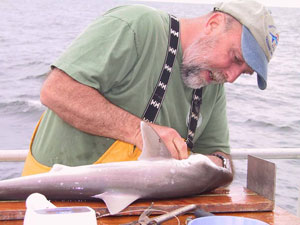Fisheries Research at MRRI
Coastal Shark Studies 
Coastal shark studies are conducted in the estuaries and nearshore coastal waters from Port Royal Sound to Bulls Bay and are funded by the National Marine Fisheries Service (Highly Migratory Species Group) and the State Recreational Fishing License Program.
The COASTSPAN project (Cooperative Atlantic States Shark Pupping and Nursery Habitat Survey) was started in 1998 to fulfill the need for data on how our estuaries are utilized by sharks. The program is funded by the National Marine Fisheries Service and data generated by this project is used for a multitude of studies as well as being utilized for stock assessment. Sharks are caught using a variety of methods; in the estuaries sharks are captured using hand deployed bottom longlines and gill nets in the bays, sounds and nearshore areas sharks are tagged using a hydraulic deployed bottom longline. The sharks are brought on board, measured for fork and total length, tagged and released.

The primary users of South Carolina's estuaries are the Atlantic sharpnose, the sandbar, the bonnethead, the blacktip, the finetooth, and the scalloped hammerhead. The spinner, the bull and the blacknose shark are also observed to a lesser degree. These sharks usually arrive in the estuaries in the spring when the water temperatures reaches 19-20° C and start moving offshore in the fall when temperatures drop below 26° C. Under the current regulation there are only two sharks that recreational anglers can keep that they are likely to encounter under normal fishing circumstances:
- Atlantic sharpnose shark
- Bonnethead shark.
All of the other species listed above must have a minimum fork length of 54 inches. Fork length is measured from the tip of the shark's nose to the fork in the caudal fin (tail). A shark with a 54" fork length would have an approximate total length of 5 1/2 to 6 feet.
Other sharks that may be encountered inshore that are not primary users of the estuary are the Nurse and Lemon Sharks. Sharks that may be encountered nearshore are all of the above species as well as the tiger, sand tiger, and dusky Sharks and in the winter months the smooth and spiny dogfish. In addition to long-term data collection and population monitoring, a study is being conducted on site fidelity in bonnethead sharks utilizing Passive Integrated Transponder (PIT) tags and external tags. We hope to learn more about bonnethead's utilization of our estuaries as well as migration and eternal tag loss.
